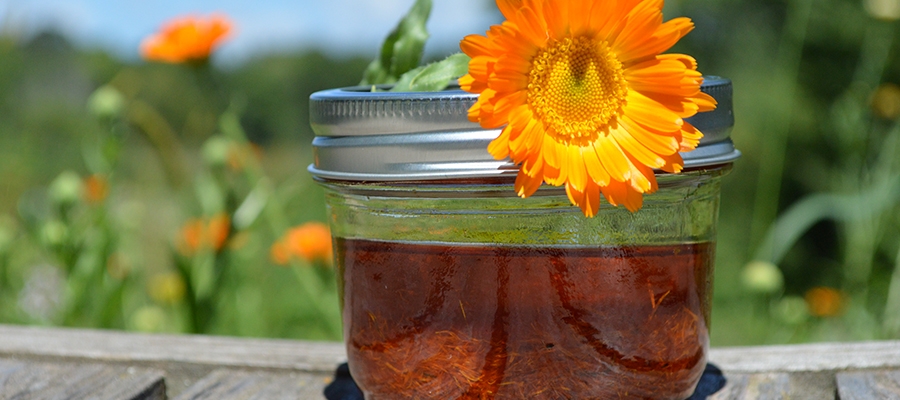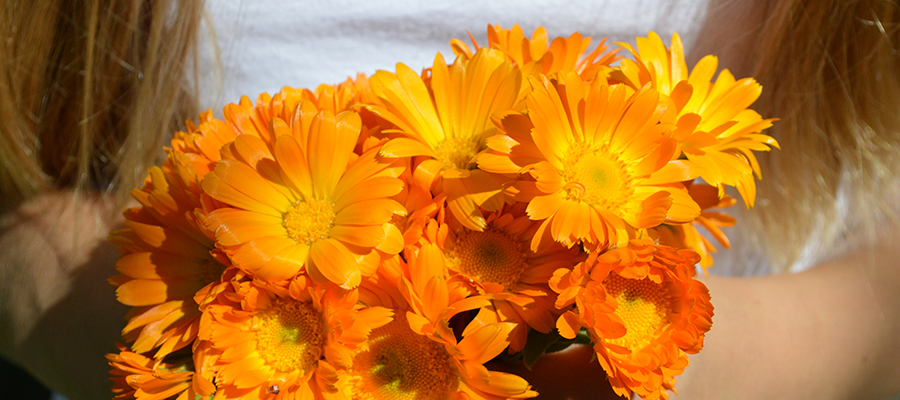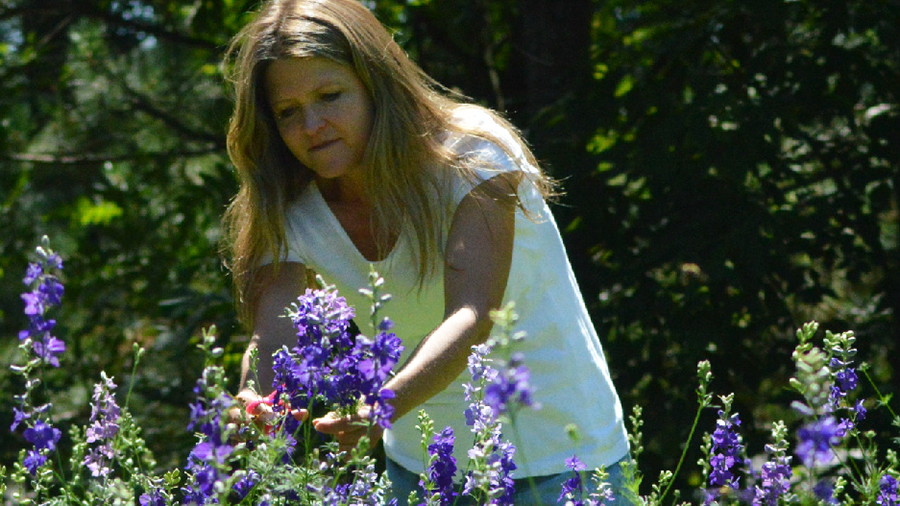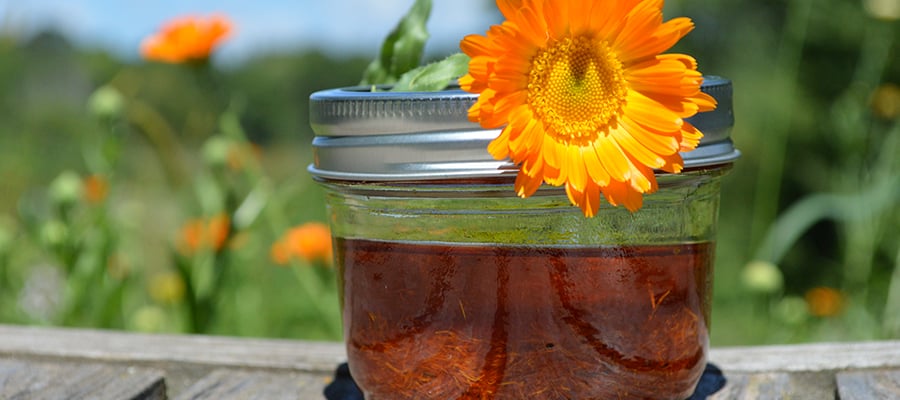
Photo Credit: Kimberly Konkol
Calendula officinalis (L.) has become one of my favorite flowers; as it has a beautiful golden flower, is easy to grow, and is great for the skin. The petals of calendula contain constituents that have anti-inflammatory, antiseptic, and antibacterial potential; helping the skin in a variety of ways. Research has shown calendula's powerful benefits to the skin. Calendula provides support to: [1] [2]
-
Soothe and soften the skin
-
Prevent rashes
-
Regenerate the skin by assisting cell rejuvenation
-
Reduce inflammation
-
Speed healing burns, bruises and cuts
-
Prevent dry skin and wrinkles
-
Reduce the appearance of scars
-
Soothe mouth sores
- Prevent and repair photo-damage
Capturing the healing properties in Calendula
The healing properties of calendula can be extracted by creating an oil infusion. An oil infusion is great to use on the skin and mucous membranes, as the medicinal properties it contains are held on the skin longer, prolonging its healing action.
A variety of different oils can be used for an infusion, each providing their own unique properties. Sunflower seed oil is easy to find, is affordable, while providing many therapeutic benefits to the skin. Sunflower seed oil helps to: [3]
- Prevent skin dryness and wrinkles
-
Reduce inflammation
-
Promote wound healing
-
Nourish dry and damaged skin
-
Protect the skin against photo-damage and photo-aging
-
Soften and soothe the skin
- Repair and maintain skin barrier function
Making Calendula infused oil
The amount of oil and calendula petals used for the infusion depends on how much you want to make. It is better to make less and have it stay fresh; you can always make more. Place the calendula petals in a jar and add enough oil to cover the petals. More oil may be needed as the petals soak up the oil. Infuse for two to three weeks, stirring or shaking daily. If you desire a stronger infusion, a double infusion can be done. To create a double infusion, strain out the petals and add new dried petals to the oil; infuse for another two to three weeks. Use cheesecloth or some other fine weave cloth to strain the oil.
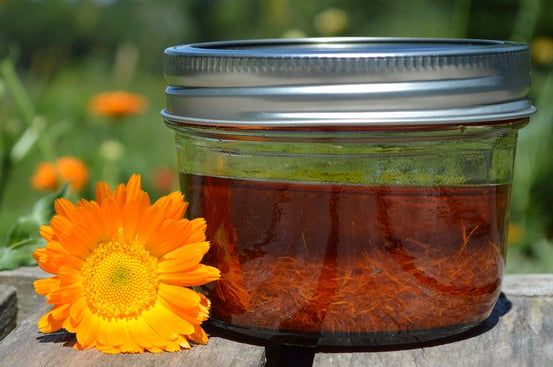
Photo Credit: Kimberly Konkol
Calendula-infused oil can be used directly or to create an ointment or cream. It is wonderful for dry chapped lips and skin in the winter, while also helping protect against photo-damage and photo-aging with days spent in the summer sunshine. It is also helpful for those unexpected insect bites, stings and scrapes.
Fresh calendula petals can also be used directly applied to a scrape or bump. The petals will help to stop mild bleeding, reduce swelling, and promote healing. Place a few petals on a cut, scrape, or sting and hold in place with a bandage. Replace with fresh petals every few hours. Tincture of calendula can also be used to support wound healing. [2]
Calendula Safety
Although calendula has been shown to be very safe, those who are pregnant are advised not to use calendula orally or topically. Calendula can also cause allergies with some people who are sensitive to the Asteraceae family, such as ragweed, chrysanthemums, marigolds, and daisies.
Although Calendula can be effective at healing skin tissue and preventing infection, it should not be used on wounds where infection is present or on wounds that are deep. Calendula can heal the top layer of the skin quickly, trapping in the infection.
References
[1] Mishra, A. K., Mishra, A., & Chattapadhyay, P. (2010). Calendula officinalis: An important herb with valuable therapeutic dimensions - An overview. Journal of Global Pharma Technology, 2(10). doi: 10.1234/jgpt.v2i10.288
[2] Verman, P. K., Raina, R., Agarwal, S., & Kour, H. (2018). Phytochemical ingredients and pharmacological potential of calendula officinalis linn. Pharmaceutical and Biomedical Research, 4(2), 1-17. doi: 10.18502/pbr.v4i2.214
[3 Stoia, M., & Oancea, S. (2015). Selected evidence-based health benefits of topically applied sunflower oil. Applied Science Reports, 10(1), 45-49. doi: 10.15192/PSCP.ASR.2015.10.1.4549
About American College of Healthcare Sciences
 Founded in 1978, ACHS.edu is a Portland, Ore.-based, accredited college offering online, on-campus, and study abroad integrative health education. With undergraduate and graduate degrees, diplomas, certificates, and continuing education units in integrative health, ACHS makes holistic health and wellness education accessible to a diverse community, including healthcare professionals, military students, stay-at-home parents, and lifelong learners. Specializations include aromatherapy, herbal medicine, holistic nutrition, wellness coaching, and integrative health modalities. ACHS is a Certified B Corporation® and was named three of 100 Best Green Workplaces in Oregon 2019 by Oregon Business magazine. ACHS is also accredited by the Distance Education Accrediting Commission (DEAC), which is recognized by the U.S. Department of Education and by the Council for Higher Education Accreditation (CHEA). In response to our commitment to service members, veterans and military spouses, ACHS has been designated as one of the top 15% of military-friendly institutions in the U.S. for nine years in a row. For more information visit achs.edu.
Founded in 1978, ACHS.edu is a Portland, Ore.-based, accredited college offering online, on-campus, and study abroad integrative health education. With undergraduate and graduate degrees, diplomas, certificates, and continuing education units in integrative health, ACHS makes holistic health and wellness education accessible to a diverse community, including healthcare professionals, military students, stay-at-home parents, and lifelong learners. Specializations include aromatherapy, herbal medicine, holistic nutrition, wellness coaching, and integrative health modalities. ACHS is a Certified B Corporation® and was named three of 100 Best Green Workplaces in Oregon 2019 by Oregon Business magazine. ACHS is also accredited by the Distance Education Accrediting Commission (DEAC), which is recognized by the U.S. Department of Education and by the Council for Higher Education Accreditation (CHEA). In response to our commitment to service members, veterans and military spouses, ACHS has been designated as one of the top 15% of military-friendly institutions in the U.S. for nine years in a row. For more information visit achs.edu.
This article is for informational purposes only. It is not intended to treat, diagnose, cure, or prevent disease. This article has not been reviewed by the FDA. Always consult with your primary care physician or naturopathic doctor before making any significant changes to your health and wellness routine.

